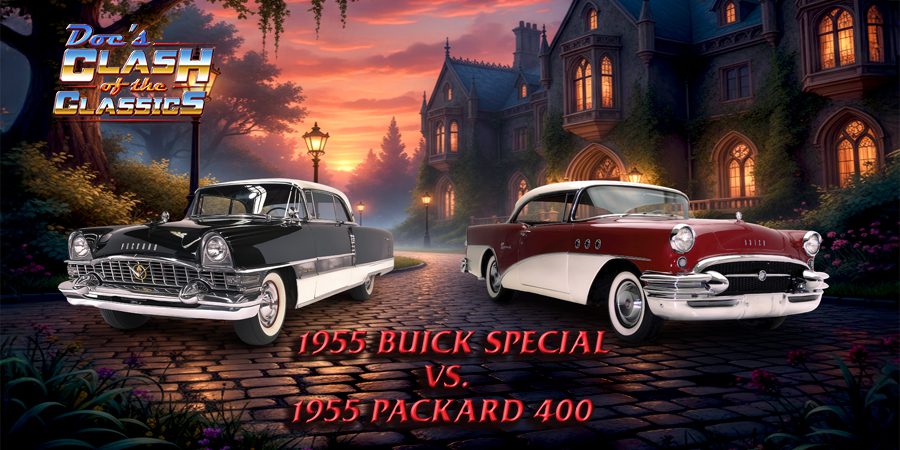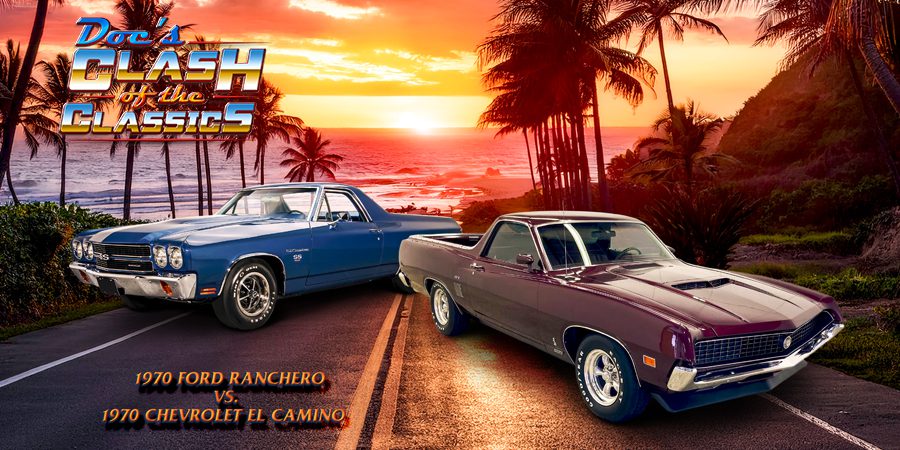Welcome, once again to Clash of the Classics. This month we’ll take a trip down memory lane to 1955 to visit two cars that helped define the decade. Todays showdown will feature the 1955 Buick Special battling the 1955 Packard 400.
1955 was a great time here in America, the economy was booming, Bill Haley and the Comets released their number 1 hit “Rock around the Clock”, and the Brooklyn Dodgers beat the New York Yankees to win their first World Series title.
In the automotive world, Buick was setting sales records that would stand for nearly 30 years. The Buick Special was largely responsible for the huge success GM was experiencing and their profit margins were becoming the envy of all automotive manufacturers.
 Post-war prosperity gave rise to bold styling, powerful new engines, and a culture where cars became more than transportation—they were statements of identity. Among the many standouts of 1955, the Buick Special two-door hardtop represented the perfect balance of affordability, style, and performance. For many families, it was the gateway into the Buick brand, offering a taste of luxury without Cadillac prices.
Post-war prosperity gave rise to bold styling, powerful new engines, and a culture where cars became more than transportation—they were statements of identity. Among the many standouts of 1955, the Buick Special two-door hardtop represented the perfect balance of affordability, style, and performance. For many families, it was the gateway into the Buick brand, offering a taste of luxury without Cadillac prices.
By the mid-1950s, Buick was thriving as one of General Motors’ strongest divisions. Positioned just below Cadillac in GM’s hierarchy, Buick offered prestige and comfort at a price point accessible to middle-class buyers who wanted something more upscale than Chevrolet or Pontiac.
In 1955 Buick sold nearly 781,000 cars—making it the third best-selling brand in America. As we mentioned earlier, the Special accounted for a large portion of those sales, with the two-door hardtop, officially called the Riviera hardtop, being one of the most stylish options in the lineup.
 Signature Buick details abounded, such as the “Sweepspear” body side molding, which flowed in a graceful arc from the front fender to the rear quarter panel. The car also sported Buick’s trademark “Venti-ports” on the front fenders, a carryover styling cue meant to suggest power and speed. Wide whitewall tires and full wheel covers completed the upscale appearance.
Signature Buick details abounded, such as the “Sweepspear” body side molding, which flowed in a graceful arc from the front fender to the rear quarter panel. The car also sported Buick’s trademark “Venti-ports” on the front fenders, a carryover styling cue meant to suggest power and speed. Wide whitewall tires and full wheel covers completed the upscale appearance.
Inside, the Special offered two-tone upholstery choices and chrometrimmed dashboards that reflected mid-century modern design.
Under the hood, the 1955 Buick Special came standard with Buick’s proven Nailhead V8 engine. Displacing 264 cubic inches, it delivered 188 horsepower—respectable power for a base model car of the time. Buyers seeking more performance could upgrade to the 236-horsepower version of the 322-cubic-inch Nailhead, shared with higher-level Buicks.
 Transmission choices included a three-speed manual or Buick’s smooth Dynaflow automatic, which was a popular option. Incidentally, 1955 was the year GM introduced the variable-pitch stator, many of us oldtimers referred to it as the switch-pitch converter. (In an upcoming GEARS article we will look at the Dynaflow in detail, stay tuned for that).
Transmission choices included a three-speed manual or Buick’s smooth Dynaflow automatic, which was a popular option. Incidentally, 1955 was the year GM introduced the variable-pitch stator, many of us oldtimers referred to it as the switch-pitch converter. (In an upcoming GEARS article we will look at the Dynaflow in detail, stay tuned for that).
While the Special wasn’t built to be a muscle car, it delivered confident cruising power, especially on the newly expanding interstate highways.
Driving a 1955 Buick was as much about comfort as speed. With its wide stance, sturdy chassis, and soft suspension, the Special provided a smooth ride that matched Buick’s reputation for quiet, effortless motoring.
What made the 1955 Buick Special two-door hardtop so appealing was its ability to deliver luxury styling and V8 power at an attainable price. Starting at around $2,300, it cost more than a Chevy Bel Air but significantly less than a Cadillac Series 62. For many middle-class buyers, the Special was the ideal compromise: upscale enough to impress the neighbors, yet affordable enough to fit the family budget.
Buick advertised the Special as the car that offered “more Buick for less money.” The hardtop version in particular appealed to younger buyers and families who wanted something sporty without giving up comfort.
Most of us will agree, the mid-’50s American car scene was dominated by fins, chrome, and horsepower, and the Buick Special fit right in. It was a car you might see parked at a drive-in theater, cruising down Route 66, or lined up at the local diner on a Friday night. The two-door hardtop gave it a youthful, fashionable edge that made it more than just transportation.
Today, the 1955 Buick Special two-door hardtop stands as a snapshot of 1950s optimism. It represents a time when American automakers weren’t afraid to use chrome liberally, experiment with bold styling, and build cars that symbolized prosperity.
For classic car enthusiasts, the 1955 Buick Special holds a unique niche. It may not command the high values of rare Cadillacs or Corvettes, but it remains highly desirable among collectors who appreciate 1950s design. Restored examples showcase the sweeping lines and chrome detailing that make mid-’50s Buicks so eye-catching at car shows. The 1955 Buick Special two-door hardtop perfectly embodied the spirit of its era: stylish, powerful, and aspirational, yet practical enough for everyday Americans. It allowed thousands of families to enjoy Buick prestige without breaking the bank, all while delivering comfort and performance that made it a joy to drive.
Nearly seventy years later, it stands as a testament to mid-century design and Buick’s place in American car culture. For enthusiasts, it represents not only a piece of history but also a rolling reminder of the optimism and style that defi ned the 1950s.
 Now let’s look at the 1955 Packard 400.
Now let’s look at the 1955 Packard 400.
To say the mid-1950’s were fiercely competitive in the automotive world would be a pretty serious understatement. American automakers were looking to capture the hearts of drivers with bold styling, modern engineering, and luxury features. For Packard, one of the nation’s oldest and most respected car manufacturers, the year 1955 marked both a turning point and a bold attempt to regain prominence in the upper tier of the market. At the center of this effort was the 1955 Packard 400, a model that embodied elegance, innovation, and the timeless craftsmanship that had long defi ned the brand.
The Packard 400 was the senior two-door hardtop coupe in the company’s lineup, positioned just below the top-of-the-line Caribbean convertible. It carried the sleek, modern look that Packard desperately needed to stay competitive against Cadillac, Lincoln, and Chrysler’s Imperial. The 400’s exterior was marked by sharp, flowing lines, tasteful chrome trim, and Packard’s distinctive cathedral-style taillights.
 One of the most striking visual updates for 1955 was the introduction of two-tone and even tri-tone paint schemes. This style reflected the postwar consumer appetite for bold, optimistic designs. Combined with Packard’s iconic grille and Jet Age-inspired details, the 400 exuded prestige without being ostentatious.
One of the most striking visual updates for 1955 was the introduction of two-tone and even tri-tone paint schemes. This style reflected the postwar consumer appetite for bold, optimistic designs. Combined with Packard’s iconic grille and Jet Age-inspired details, the 400 exuded prestige without being ostentatious.
Inside, the Packard 400 delivered on luxury. Plush upholstery, thick carpeting, and tasteful chrome accents filled the cabin. Power accessories, such as windows and seats, were available, and air conditioning—still a rarity in 1955—could be ordered, reinforcing Packard’s reputation as a builder of upscale automobiles.
While style was critical in the mid-1950s, Packard also made sure the 400 was more than just a pretty face. The 1955 model year introduced one of the company’s most important engineering developments: the Packard V8. A 352-cubic-inch engine producing an impressive 260 horsepower. This modern overhead-valve V8 replaced the aging straight-eight engines Packard had relied on for decades and instantly gave the brand renewed credibility in terms of performance.
 Backing the new V8 was the Ultramatic transmission. It provided smooth, refi ned shifts and could be paired with push-button controls in later years. Though sometimes criticized for durability issues, it was a technologically ambitious effort that underscored Packard’s desire to remain innovative. During my years as a transmission shop owner/operator, we had several occasions to work with this unit. As with most things in life, early experiences can be painful due to lack of familiarity. This was certainly the case with our first Ultramatic rebuilds. Here today, we are quite comfortable with them and before retiring, I grew to enjoy working on them.
Backing the new V8 was the Ultramatic transmission. It provided smooth, refi ned shifts and could be paired with push-button controls in later years. Though sometimes criticized for durability issues, it was a technologically ambitious effort that underscored Packard’s desire to remain innovative. During my years as a transmission shop owner/operator, we had several occasions to work with this unit. As with most things in life, early experiences can be painful due to lack of familiarity. This was certainly the case with our first Ultramatic rebuilds. Here today, we are quite comfortable with them and before retiring, I grew to enjoy working on them.
Perhaps the most groundbreaking feature available on the 1955 Packard 400 was the Torsion-Level suspension system. This advanced setup used interconnected torsion bars along with an automatic leveling system that adjusted the car’s height based on load. The result was an exceptionally smooth ride that critics often described as one of the best in the industry. Packard promoted it heavily, and for good reason—it was a genuine engineering triumph that gave the 400 an edge over competitors.
Priced at around $4,000 in 1955, the Packard 400 was squarely aimed at buyers who might otherwise shop Cadillac or Lincoln. The model’s blend of refinement, power, and cutting-edge suspension technology made it highly competitive on paper.
However, Packard was facing larger challenges that no single model could completely solve. The company had recently merged with Studebaker, and financial pressures, along with a dealer network in flux, made it difficult to compete against the resources of General Motors and Ford. Sales of the 400 were respectable for Packard but paled in comparison to Buick’s dominance in the automotive market.
Despite the obstacles facing the company, the 1955 Packard 400 remains a significant milestone in automotive history. It represented Packard’s last major push to reclaim leadership in the luxury field through a combination of style, engineering, and tradition. Collectors today admire the 400 not only for its rarity but also for its innovative suspension, distinctive styling, and smooth V8 power.
For many enthusiasts, the 1955 model 400 captures the essence of Packard’s final great era. It stands as both a reminder of the company’s illustrious past and a symbol of its struggle to adapt in a rapidly changing market. While Packard’s fortunes would soon decline, the 400 remains a treasured classic, celebrated by enthusiasts as one of the last truly great Packards.
Now comes the difficult part as there must be a winner in today’s battle. For all of us here at Clash of the Classics, choosing a victor in this month’s Clash battle proved to be more challenging than usual. For me personally, both cars are outstanding in terms of design and styling but the Packard gets the nod by the slimmest of margins. It’s often entertaining to consider what vehicles Packard would be producing today if only they could have survived. As always, we’d love to hear from you, let us know which car you prefer and why. Until next time when we take a ride on a classic highway, stay safe… stay timeless…stay classic!
About The Author
Donny Caccamise is an Automotive Technology Graduate and a Certifi ed Master Technician with more than 40 years of automotive industry experience. Before retiring, he hosted the Nationally Syndicated Automotive Talk Radio Show “Horsepower for an Hour” airing on 161 AM and FM radio stations across the nation. He is a retired member of the ATRA Board of Directors, and retired transmission shop owner. Vintage and classic cars are his specialty. Contact Donny at donnycaccamise@gmail.com.














